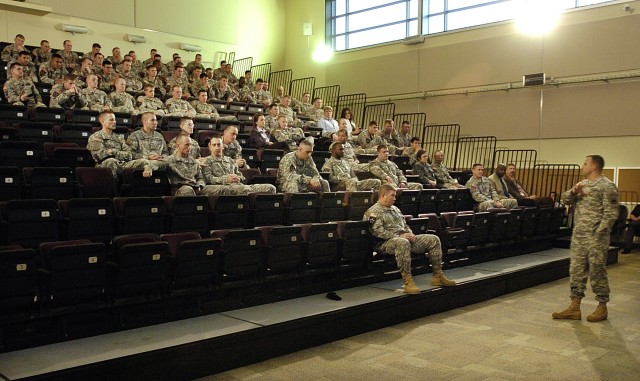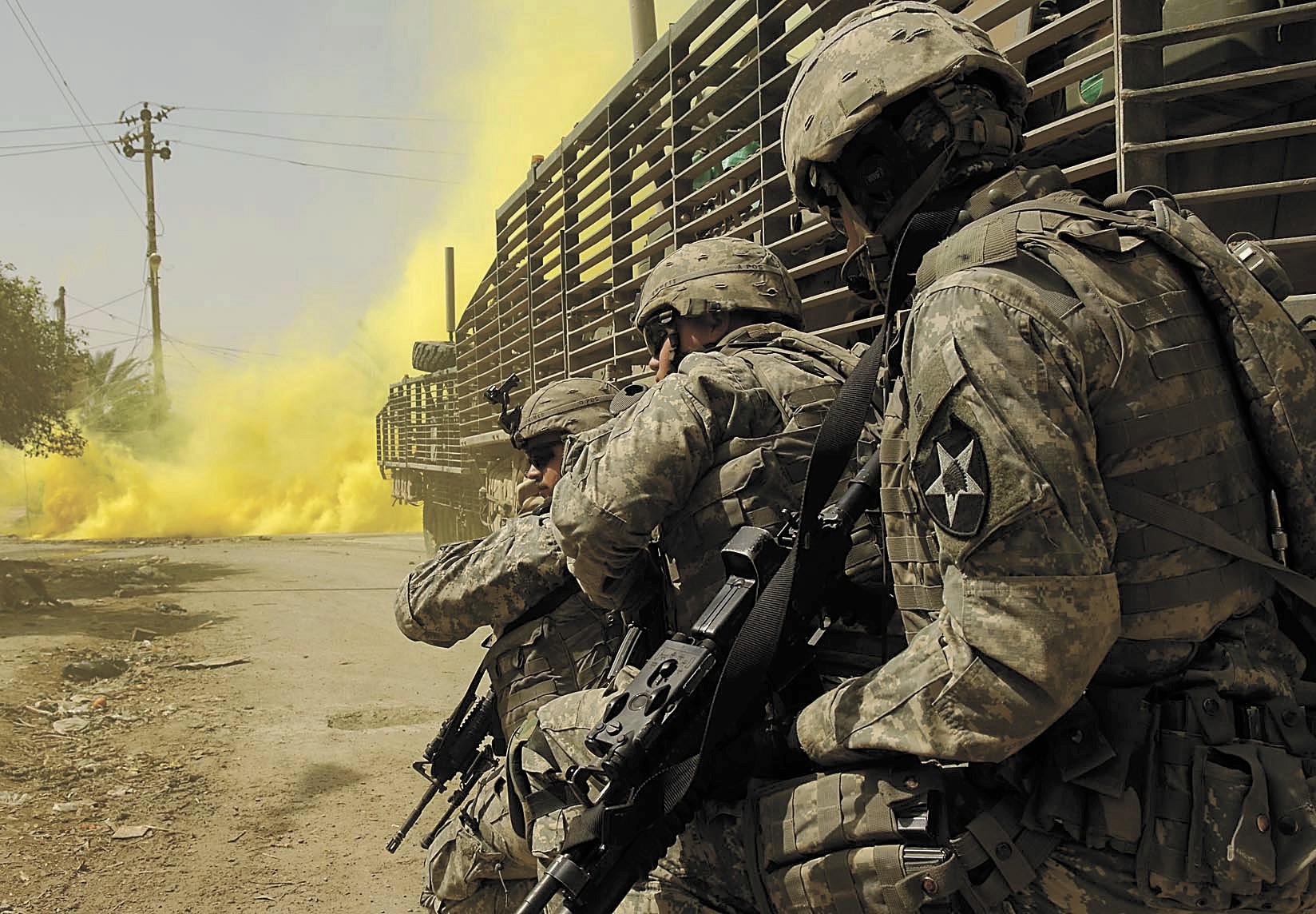FORT LEWIS, Wash. - For most of Sykes' Regulars, Baqubah was the source of their greatest pride and their worst nightmares.
The battle for the capital of Diyala Province during the U.S. troop surge of 2007, is already a topic of discussion among military analysts and historians.
"Baqubah was arguably the most significant campaign of the war in Iraq after the initial invasion was completed," said Dr. Bill Reeder, the chief of leader development at the I Corps Battle Command Training Center.
The 5th Battalion, 20th Infantry Regiment Soldiers remaining at Fort Lewis who joined that struggle went to a movie premiere of sorts on June 5, a viewing more sober than gala.
The BCTC staff spent months processing the battle with its participants, piecing together interviews, still photos and videos shot by Soldiers themselves. The aim was to produce a linear account on DVD of the extended battle in the hope of distilling lessons for the counterinsurgency fight and future U.S. warfare.
The BCTC staff conducted the interviews as part of its SLA Marshall series, which debriefs key personnel on video to capture living histories for the use of Soldiers, DA civilians and leaders of future operations.
Any Army Knowledge Online account holder with secure access can view the interview series on StrykerNet.com.
Recently, Reeder's team realized from the interviews, they could chronicle more complex combat situations. They assembled accounts of the Zarqa and Haifa Street battles, then tackled Baqubah as their most ambitious project.
When they finished, the former 5-20 Inf. commander, Lt. Col. Bruce Antonia, suggested the first showing of the 90-minute video be reserved for the Soldiers who fought and sacrificed in Baqubah.
"Lots of people are studying this battle," Antonia told the Soldiers assembled to watch. "You were involved in a hugely important, pivotal battle. Hopefully you'll pull (the DVD) out in about 20 years, pop it into the DVD player and say 'I was a part of this.'"
Task Force Regulars fought its way from neighborhood to neighborhood, taking back a city 35 miles northeast of Baghdad that Abu Musab al-Zarqawi, al-Qaida-in-Iraq's notorious former leader, had declared the new Islamic state's capital.
The efforts of 5-20 Inf. lifted the fortunes of Operation Iraqi Freedom, validated the Multinational Forces commander, Gen. David Petraeus' counterinsurgency strategies and showed a nation turning more dubious of the conflict that U.S. forces could win the COIN struggle for Iraq a street at a time, despite the heavy price.
The Regulars embarked on what intelligence sources told them was to be a 24-hour operation to clear date palm groves; they found themselves instead in the early stages of a six-month struggle against a wide array of insurgents, including the most determined and sophisticated al-Qaida fighters anywhere in the world.
Task Force 5-20 rolled into a quiet Baqubah on March 13, but craters from detonated improvised explosive devices pocked the thoroughfares.
"There was nobody on the streets," Staff Sgt. Stuart Fowler said, currently assigned to the BCTC, a team leader during the battle who was among the first into the city. "It was kind of like a ghost town. There were some people about, but when we started rolling in there, things started kicking off. I mean deep buried IEDs, people getting injured, vehicles blowing up."
Combat started almost immediately. A 5-20 Inf. Soldier lost his life March 14 when his Stryker hit an IED; 14 more were wounded that day alone. Captain Ben Richards, commander of B Troop, 1st Battalion, 14th Cavalry Regiment said his unit hit two IEDs within its first 20 minutes in the city, contact that turned into a 12-hour small-arms gun battle.
"We really felt like we were being attacked by everybody," Command Sgt. Maj. Jeff Huggins said. "Not just a couple of insurgents here and there. This was the whole neighborhood attacking you."
The battalion-plus walked and rode its Strykers into a major urban campaign, at minimum a brigade-sized fight, that lasted nearly three months until help finally arrived from a sister unit, 1st Battalion, 23rd Infantry Regiment. When the rest of 3rd Brigade, 2nd Infantry Division arrived, 5-20 Inf. used its hard-earned experience to spearhead the Arrowhead Ripper operation that cleared much of Diyala Province.
Soldiers in the BCTC auditorium heard the accounts and saw the images that took them back to their experience.
Staff Sgt. Mike Marker, a B Company squad leader, remembered rolling into Baqubah the first day, wondering "why are the kids in the school holding their ears'" A deafening explosion followed seconds later, signaling an ambush.
Antonia said the video illustrated a shift in philosophy about command-and-control in counterinsurgency warfare.
"My after action review said the Soldiers and junior leaders on the ground are winning this war," Antonia said. "We even at battalion level and up, can only rely on resourcing subordinate units and influencing governmental processes. That's it. I don't fight companies, I don't fight platoons in this kind of environment. I don't say 'A Company, lay down a base of fire and B Company, bound around.' I rely heavily on subordinate leaders. I fought through company commanders (and they) made sure platoon leaders and squad leaders understood what my intent was."
The commander said his Soldiers and subordinate leaders responded beyond his expectations, at times heroically.
"There was extraordinary combat leadership every day," he said.
The video detailed another distinction earned by Sykes' Regulars. Command Sgt. Maj. Huggins said the task force conducted "the biggest air assault in Stryker history," the first Stryker force to conduct a battalion-sized air assault operation aimed at surprising insurgents operating in the southern neighborhood of Buhritz al-Abarra.
The documentary further described the civil affairs effort that accompanied combat operations, detailing the efforts of small unit leaders to interact with the population and form relationships with local leaders. Local mukhtars came to realize that the U.S. Soldiers were there to help and al-Qaida was not.
Reeder said the video was the unit's opportunity to process the events that their commander, command sergeant major and operations officer, Maj. Jack Vantress, had analyzed incessantly since their return.
"This is the first time any of them outside of those three ... have seen this product," Reeder said, "the first time many will sit there and revisit their experiences."
Marker, who said he often consciously pushed the memories out of his mind, hailed the presentation as an accurate depiction of events.
The video was also intended for newly arrived Soldiers, "those new members of the battalion in their retrain phase who will benefit greatly from seeing this documentary."
"It was very well put together," Fowler said after the preview. "Very well detailed too."
He said he was glad that the Regulars' experience in Baqubah was being used to train other units.
"Knowledge is the key to success," he said. "All the knowledge I have, I try to pass it on."
A decorated helicopter pilot and prisoner of war in Vietnam, Reeder told the assembled battalion that he respected their accomplishments.
"I am in awe of your experience in Baqubah," Reeder said before the preview. "You performed superbly for the United States of America and what you did for the citizens of Iraq and the citizenry of Baqubah in liberating those people was an extraordinary feat that you will be proud of for the rest of your days. It is our honor to be part of putting this video together and for hosting this video for you."
Don Kramer is a reporter for Fort Lewis' Northwest Guardian.




Social Sharing